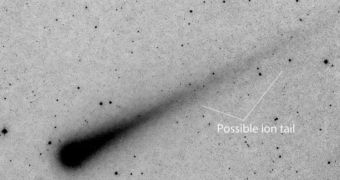Recent observations of Comet ISON show what could very well be a new ion tail sprouting up behind the large ball of ice. As it nears its point of closest approach to the Sun, called the perihelion, the comet is beginning to show bizarre behaviors that thrill astronomers.
Numerous telescopes around the world are now trained on the object, which is also known as Comet Nevski–Novichonok or C/2012 S1. Scientists say it is a sungrazing comet, which means that it passes extremely close to the Sun before making its way out of the inner solar system again.
At perihelion, ISON will fly just 1.86 million kilometers (1.15 million miles) away from the center of the Sun, or about 1.16 million kilometers (724,000 miles) above the star's actual surface. It could be that this proximity will destroy the comet, whose hyperbolic trajectory indicates that it may have escaped the Oort Cloud beyond the Kuiper Belt only recently.
As astronomers watched the 5-kilometer (3.1-mile) comet, its first dust and ice tail began to form months ago, eventually growing to cover the equivalent of the diameter of a full Moon on the night sky, or roughly half a degree. However, recent images suggest a new tail is developing.
Usually, the ion tail of a comet consists of gases including carbon monoxide and carbon dioxide, which are drawn from the object's surface as it is battered by intense solar winds. Ultraviolet radiations from the star ionize these chemicals, which then begin to glow intensely.
In some cases, the ion Tails can take on weird appearances and directions, due to shifts in the intensity and direction of the magnetic fields emanating from the Sun. Intense solar activity can cause tails to appear skewed, while large coronal mass ejections or solar flares can even destroy them.
As Comet ISON nears the Sun and accelerates – preparing for the slingshot maneuver that will throw it into the farthest reaches of space – its false nucleus is becoming more compact, and its brightness soars. Astronomers predict that its brightness may increase even further by the time it reaches its perihelion, on November 28.
Astronomers are waiting to see what will happen to the comet when it reaches a threshold distance of 0.8 astronomical units from the Sun.
At this distance, which is the equivalent of 1.2 billion kilometers, or 744 million miles, previous comets including C/1999 S4 LINEAR and C/2010 X1 ELENIN broke apart and were destroyed by the star's fiery heat, Universe Today reports.

 14 DAY TRIAL //
14 DAY TRIAL //